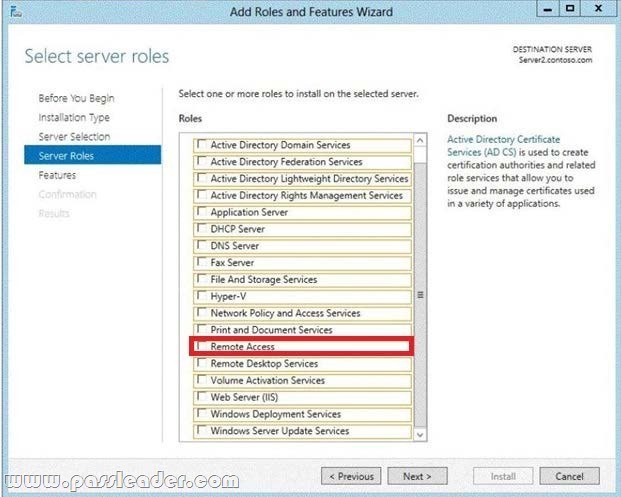Valid 70-410 Dumps shared by PassLeader for Helping Passing 70-410 Exam! PassLeader now offer the newest 70-410 VCE dumps and 70-410 PDF dumps, the PassLeader 70-410 exam questions have been updated and ANSWERS have been corrected, get the newest PassLeader 70-410 dumps with VCE and PDF here: http://www.passleader.com/70-410.html (512 Q&As Dumps –> 528 Q&As Dumps)
BTW, DOWNLOAD part of PassLeader 70-410 dumps from Cloud Storage: https://drive.google.com/open?id=0B-ob6L_QjGLpfnJzOE1fWnlJOWVtaE93SnJNT3gtaTNYYnVpZkw5THBSMWRKbFlfaXh1azg
QUESTION 201
In an isolated test environment, you deploy a server named Server1 that runs a Server Core Installation of Windows Server 2012 R2. The test environment does not have Active Directory Domain Services (AD DS) installed. You install the Active Directory Domain Services server role on Server1. You need to configure Server1 as a domain controller. Which cmdlet should you run?
A. Install-ADDSDomainController
B. Install-ADDSDomatn
C. Install-ADDSForest
D. Install-WindowsFeature
Answer: C
Explanation:
Install-ADDSDomainController – Installs a domain controller in Active Directory.
Install-ADDSDomain – Installs a new Active Directory domain configuration.
Install-ADDSForest – Installs a new Active Directory forest configuration.
Install-WindowsFeature – Installs one or more Windows Server roles, role services, or features on either the local or a specified remote server that is running Windows Server 2012 R2. This cmdlet is equivalent to and replaces Add-WindowsFeature, the cmdlet that was used to install roles, role services, and features.
http://technet.microsoft.com/en-us/library/hh974720%28v=wps.620%29.aspx
QUESTION 202
Your network contains an Active Directory domain named adatum.com. You discover that when users join computers to the domain, the computer accounts are created in the Computers container. You need to ensure that when users join computers to the domain, the computer accounts are automatically created in an organizational unit (OU) named All_Computers. What should you do?
A. From a command prompt, run the redircmp.exe command.
B. From Windows PowerShell, run the Move-ADObject cmdlet.
C. From Ldp, configure the properties of the Computers container.
D. From ADSI Edit, configure the properties of the OU1 object.
Answer: A
Explanation:
http://technet.microsoft.com/en-us/library/cc770619.aspx
Redirects the default container for newly created computers to a specified, target organizational unit (OU) so that newly created computer objects are created in the specific target OU instead of in CN=Computers.
QUESTION 203
Drag and Drop Question
You are configuring a test network. The test network contains a subnet named LAN1. LAN1 uses the network ID of 10.10.1.0/27. You plan to add a new subnet named LAN2 to the test network. LAN1 and LAN2 will be connected by a router. You need to identify a valid network ID for LAN2 that meets the following requirements:
– Ensures that hosts on LAN2 can communicate with hosts on LAN1.
– Supports at least 100 IPv4 hosts.
– Uses only private IP addresses.
Which network ID should you use? To answer, drag the appropriate network ID and subnet mask to the correct location in the answer area.

QUESTION 204
Hotspot Question
You have a Hyper-V host named HYPERV1. HYPERV1 hosts a virtual machine named DC1. You need to prevent the clock on DC1 from synchronizing from the clock on HYPERV1. What should you configure? To answer, select the appropriate object in the answer area.

QUESTION 205
Hotspot Question
Your network contains a subnet named Subnet1. Subnet1 contains a DHCP server named Server1. You deploy a new subnet named Subnet2. On Subnet2, you deploy a new server named Server2 that runs Windows Server 2012 R2. You need to configure Server2 to route DHCP broadcast from Subnet2 to Server1. Which server role should you install on Server2? To answer, select the appropriate role in the answer area.

QUESTION 206
Your network contains an Active Directory domain named contoso.com. The domain contains a user account named User1 that resides in an organizational unit (OU) named OU1. A Group Policy Object (GPO) named GPO1 is linked to OU1. GPO1 is used to publish several applications to a user named User1. In the Users container, you create a new user named User2. You need to ensure that the same applications are published to User2. What should you do?
A. Modify the security of GPO1.
B. Modify the settings in GPO1.
C. Link a WMI filter to GPO1.
D. Move User2 to OU1.
Answer: D
Explanation:
The GPO is linked to OU1. By moving User2 to OU1 the GPO will be applied to this user.
QUESTION 207
Drag and Drop Question
Your network contains an Active Directory domain named contoso.com. The domain contains a member server named Server1. Server1 runs Windows Server 2012 and has the File Server server role installed. On Server1, you create a share named Documents. The Share permission for the Documents share is configured as shown in the following table.

The NTFS permission for the Documents share is configured as shown in the following table.

You need to configure the Share and NTFS permissions for the Documents share. The permissions must meet the following requirements:
– Ensure that the members of a group named Group1 can read files and run programs in – Documents. Ensure that the members of Group1 can modify the permissions on their own files in Documents.
– Ensure that the members of Group1 can create folders and files in Documents.
– Minimize the number of permissions assigned to users and groups.
How should you configure the permissions? To answer, drag the appropriate permission to the correct location. Each permission may be used once, more than once, or not at all. You may need to drag the split bar between panes or scroll to view content.

QUESTION 208
Hotspot Question
Your network contains an Active Directory forest. The forest contains two domains named Domain1 and Domain2. Domain1 contains a file server named Server1. Server1 has a shared folder named Share1. Domain2 contains 50 users who require access to Share1. You need to create groups in each domain to meet the following requirements:
– In Domain1, create a group named Group1. Group1 must be granted access to Share1.
– In Domain2, create a group named Group2. Group2 must contain the user accounts of the 50 users.
– Permission to Share1 must only be assigned directly to Group1.
Which type of groups should you create and which group nesting strategy should you use? To answer, select the appropriate configuration in the answer area.
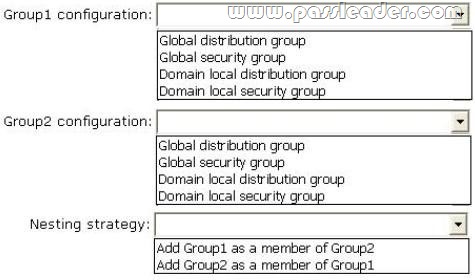
Answer:
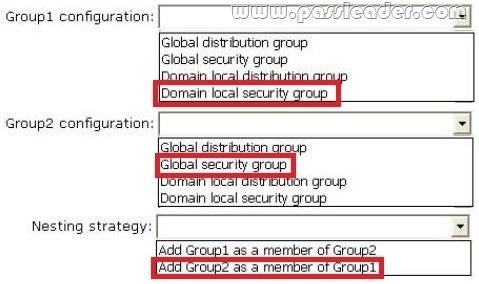
Explanation:
Any group, whether it is a security group or a distribution group, is characterized by a scope that identifies the extent to which the group is applied in the domain tree or forest. The boundary, or reach, of a group scope is also determined by the domain functional level setting of the domain in which it resides. There are three group scopes: universal, global, and domain local.
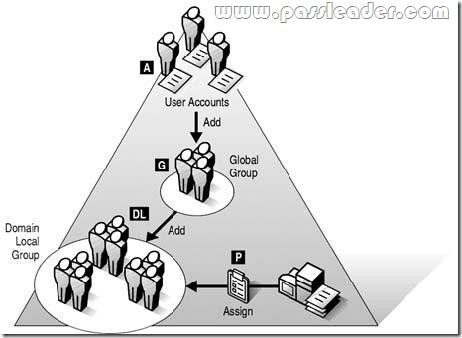
http://support.microsoft.com/default.aspx?scid=kb;EN-US;231273
http://technet.microsoft.com/en-us/library/cc772723%28WS.10%29.aspx
http://technet.microsoft.com/pt-br/library/cc728188%28WS.10%29.aspx
http://technet.microsoft.com/en-us/library/cc755692%28WS.10%29.aspx
QUESTION 209
You work as an administrator at contoso.com. The contoso.com network consists of a single domain named contoso.com. All servers on the contoso.com network have Windows Server 2012 installed. contoso.com has a server, named PL-SR07, which has the AD DS, DHCP, and DNS server roles installed. contoso.com also has a server, named PL-SR08, which has the DHCP, and Remote Access server roles installed. You have configured a server, which has the File and Storage Services server role installed, to automatically acquire an IP address. The server is named PL-SR09. You then create a filter on PL-SR07. Which of the following is a reason for this configuration?
A. To make sure that PL-SR07 issues PL-SR09 an IP address.
B. To make sure that PL-SR07 does not issue PL-SR09 an IP address.
C. To make sure that PL-SR09 acquires a constant IP address from PL-SR08 only.
D. To make sure that PL-SR09 is configured with a static IP address.
Answer: B
Explanation:
Enable and Configure MAC Address Filtering MAC address filtering (aka link-layer filtering) is a feature for IPv4 addresses that allows you to include or exclude computers and devices based on their MAC address. Denying a Single MAC Address You can see from the first figure that we’ve got a system that this DHCP server has given an address lease. Just to demonstrate the simplest possible case of MAC filtering in DHCP, let’s block that system from ever getting an IP address from this DHCP server again. To deny MAC ADDRESS from getting an IP address, right-click the PC entry in the “Address Leases” folder, then choose Add to Filter / Deny, as you see in the following figure:

At this point, the “Deny” folder has a rule in it, as you can see by opening the Filters / Deny folder:
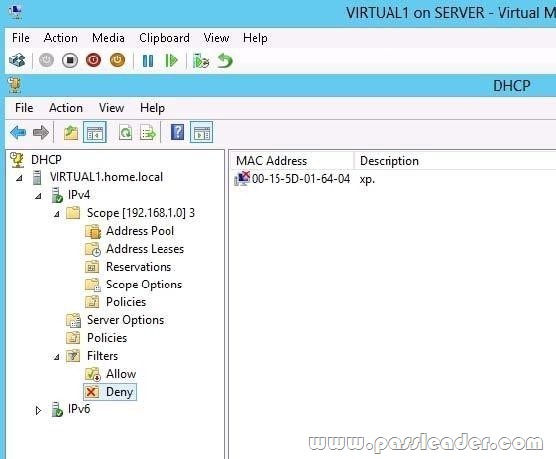
If you had more than one existing lease that you wanted to add to the “deny” filter (or, for that matter, the “allow” filter) then you could also multi-select or block-select any number of existing leases, right-click and then deny (or allow) them en masse. You must enable Deny filter for it to work.
http://technet.microsoft.com/en-us/magazine/ff521761.aspx
http://blogs.technet.com/b/teamdhcp/archive/2012/11/10/dhcp-mac-address-filter-management-made-easy-with-dhcp-powershell.aspx
http://technet.microsoft.com/en-us/library/hh831825.aspx
http://technet.microsoft.com/en-us/library/jj200226.aspx
QUESTION 210
Your network contains an Active Directory domain named contoso.com. The domain contains a server named Server1. Server1 runs Windows Server 2012 R2. You need to create 3-TB virtual hard disk (VHD) on Server1. Which tool should you use?
A. New-StorageSubsytemVirtualDisk
B. File Server Resource Manager (FSRM)
C. Server Manager
D. Computer Management
Answer: D
Explanation:
For other questions to create a VHD (file) you can use computer management.
– Share and storage management (2008 only)
– New-storagesubsystemVirtualDisk (this is a virtual disk, NOT a virtual hard disk)
– Server Manager (you would use this to create virtual disks, not virtual hard disks)
QUESTION 211
You work as an administrator at contoso.com. The contoso.com network consists of a single domain named contoso.com. Subsequent to deploying a Server Core Installation of Windows Server 2012 on a new contoso.com server, you are instructed to add a graphical user interface (GUI) to the server. You want to achieve this goal from the command prompt. Which of the following actions should you take?
A. You should consider making use of the dism.exe command.
B. You should consider making use of the dsquery.exe command.
C. You should consider making use of the dsadd.exe command.
D. You should consider making use of the dsrm.exe command.
Answer: A
Explanation:
A. Deployment Image Servicing and Management (DISM).
B. dsquery Queries the directory by using search criteria that you specify.
C. dsadd.exe: Adds specific types of objects to the directory.
D. dsrm.exe: Deletes an object of a specific type or any general object from the directory.
The Deployment Image Servicing and Management (DISM) tool replaces the pkgmgr, PEImg, and IntlConfg tools that are being retired in Windows 7. DISM provides a single centralized tool for performing all of the functions of these three tools in a more efficient and standardized way, eliminating the source of many of the frustrations experienced by current users of these tools.
http://msdn.microsoft.com/en-us/library/windows/desktop/dd371719%28v=vs.85%29.aspx
QUESTION 212
Your network contains two Hyper-V hosts that run Windows Server 2012 R2. The Hyper-V hosts contains several virtual machines that run Windows Server 2012 R2. You install the Network Load Balancing feature on the virtual machines. You need to configure the virtual machines to support Network Load Balancing (NLB). Which virtual machine settings should you configure?
A. Port mirroring
B. DHCP guard
C. Router guard
D. MAC address
Answer: D
Explanation:
http://social.technet.microsoft.com/Forums/windowsserver/en-US/5b3a0a9d-26a2-49ba-bbbe-29d11fcbb7ce/nlb-on-hyperv?forum=winserverhyperv
For NLB to be configured you need to enable MAC address spoofing.
QUESTION 213
Your network contains an Active Directory forest that contains two domains. The forest contains five domain controllers. The domain controllers are configured as shown in the following table.

You need to configure DC5 as a global catalog server. Which tool should you use?
A. Active Directory Domains and Trusts
B. Active Directory Users and Computers
C. Active Directory Administrative Center
D. Active Directory Sites and Services
Answer: D
Explanation:
If you have more than one domain in your forest and you have a significant user population in a site, you canoptimize the speed and efficiency of domain logons and directory searches by adding a global catalog server to the site. If you have a single-domain forest, global catalog servers are not required for logons, but directory searches are directed to the global catalog. In this case, you can enable the global catalog on all domain controllers for faster directory searches. You can use the same user interface (UI) in the Active Directory Sites and Services snap-in to add or remove the global catalog. Enabling the global catalog can cause additional replication traffic. However, global catalog removal occurs gradually in the background and does not affect replication or performance. Membership in the Enterprise Admins group in the forest or the Domain Admins group in the forest root domain, or equivalent, is the minimum required to complete this procedure. To add or remove the global catalog: Open Active Directory Sites and Services. To open Active Directory Sites and Services, click Start, click Administrative Tools, and then click Active Directory Sites and Services. To open Active Directory Sites and Services in Windows Server 2012, click Start , type dssite.msc. In the console tree, click the server object to which you want to add the global catalog or from which you want to remove the global catalog.
Where?
Active Directory Sites and Services\Sites\SiteName\Servers
In the details pane, right-click NTDS Settings of the selected server object, and then click Properties. Select the Global Catalog check box to add the global catalog, or clear the check box to remove theglobal catalog.
Global Catalog Servers and Sites
To optimize network performance in a multiple-site environment, consider adding global catalog servers in sites according to the needs in the sites for fast search responses and domain logons. It is recommended to make all domain controllers be global catalog severs if possible. In a single-site, multiple-domain environment, a single global catalog server is usually sufficient to cover common Active Directory queries and logons.
QUESTION 214
You work as an administrator at contoso.com. The contoso.com network consists of a single domain named contoso.com. All servers on the contoso.com network have Windows Server 2012 installed. You have received instructions to install the Remote Desktop Services server role on a server, named PL-SR07. You want to achieve this remotely from a server, named PL-SR06. Which of the following actions should you take?
A. You should consider accessing the Server Manager console on PL-SR07.
B. You should consider accessing the Server Manager console on PL-SR06.
C. You should consider accessing the TS Manager console on PL-SR07.
D. You should consider accessing the TS Manager console on PL-SR06.
Answer: B
Explanation:
Windows Server 2012 delivers capabilities to manage many servers and the devices connecting them, whether they are physical or virtual, on-premises or off. With Windows Server 2012 R2, you can rely on new management capabilities for connecting to multiple machines through a single interface, robust automation to help improve compliance, increasing efficiency through automation and creating unified experiences across physical and virtual platforms.

http://www.microsoft.com/en-us/server-cloud/windows-server/server-management-automation.aspx
http://www.techieshelp.com/windows-server-2012-install-and-configure-remote-desktop-services/
http://technet.microsoft.com/en-us/library/cc742813.aspx
http://technet.microsoft.com/en-us/library/hh831809.aspx
http://technet.microsoft.com/en-us/library/hh831456.aspx
QUESTION 215
Your network contains an Active Directory domain named contoso.com. The domain contains a server named Server1. Server1 runs Windows Server 2012 R2. You need to create 3-TB virtual hard disk (VHD) on Server1. Which tool should you use?
A. File Server Resource Manager (FSRM)
B. New-StoragePool
C. Diskpart
D. Share and Storage Management
Answer: C
Explanation:
Diskpart – “create vdisk file=c:\test.vhd maximum=3000000 type=expandable”

http://www.hyper-v.nu/archives/hvredevoort/2012/01/windows-8-storage-and-hyper-v-part-2-vhdx-andpowershell/
http://www.hyper-v.nu/archives/hvredevoort/2012/04/windows-8-storage-and-hyper-v-part-3-the-art-ofcreating-a-vhd-2/
http://technet.microsoft.com/library/hh831487
QUESTION 216
Your network contains an Active Directory domain named contoso.com. The domain contains a server named Server1 that runs Windows Server 2012 R2. You create a new inbound rule by using Windows Firewall with Advanced Security. You need to configure the rule to allow Server1 to accept unsolicited inbound packets that are received through a network address translation (NAT) device on the network. Which setting in the rule should you configure?
A. Edge traversal
B. Authorized computers
C. Interface types
D. Remote IP address
Answer: A
Explanation:
Edge traversal – This indicates whether edge traversal is enabled (Yes) or disabled (No). When edge traversalis enabled, the Application, service, or port to which the rule Applies is globally addressable and accessible from outside a network address translation (NAT) or edge device.

Select one of the following options from the list:
Block edge traversal (default) – Prevent Applications from receiving unsolicited traffic from the Internet through a NAT edge device.
Allow edge traversal – Allow Applications to receive unsolicited traffic directly from the Internet through a NAT edge device.
Defer to user – Let the user decide whether to allow unsolicited traffic from the Internet through a NAT edge device when an Application requests it.
Defer to Application – Let each Application determine whether to allow unsolicited traffic from the Internet through a NAT edge device.
http://technet.microsoft.com/en-us/library/cc731927.aspx
http://technet.microsoft.com/en-us/library/dd421713%28v=ws.10%29.aspx
QUESTION 217
Drag and Drop Question
You have a server named Server1 that runs Windows Server 2012 R2. You need to create a new volume on Server1. The new volume must have the following configurations:
– Be stored on a new virtual hard disk.
– Be assigned the drive letter G.
– Have the NTFS file system.
In which order should you run the Diskpart commands? To answer, move all the Diskpart commands from the list of commands to the answer area and arrange them in the correct order.
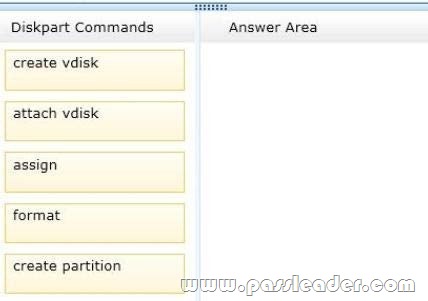
QUESTION 218
Hotspot Question
Your network contains an Active Directory domain named contoso.com. The network contains a DHCP server named DHCP1. You add a new network segment to the network. On the new network segment, you deploy a new server named Server1 that runs Windows Server 2012 R2. You need to configure Server1 as a DHCP Relay Agent. Which server role should you install on Server1? To answer, select the appropriate role in the answer area.

Answer:

Explanation:
If you opt to create a centralized or hybrid DHCP infrastructure, you will need a DHCP relay agent on every subnet that does not have a DHCP server on it. Many routers are capable of functioning as DHCP relay agents, but in situations where they are not, you can configure a Windows Server 2012 computer to function as a relay agent.
http://my.safaribooksonline.com/book/certification/9780735673151/4dot-deploying-and-configuring-core-network-services/objective_42_configure_servers_html
QUESTION 219
You work as an administrator at contoso.com. The contoso.com network consists of a single domain named contoso.com. All servers on the contoso.com network have Windows Server 2012 installed. You are in the process of installing a Server Core installation of Windows Server 2012 on a new contoso.com server, named PL-SR13. Which of the following is TRUE with regards to a installing a Server Core installation of Windows Server 2012? (Choose all that apply.)
A. The Server Graphical Shell is installed, but not enabled.
B. Server roles can be configured locally via the command prompt using Windows PowerShell.
C. Server roles can be configured locally via Server Manager.
D. You are able to access the Microsoft Management Console locally.
E. The Desktop Experience is not available.
Answer: BE
Explanation:
A. There is no Windows shell and very limited GUI functionality.
B. The Server Core interface is a command prompt with PowerShell support.
C. Only Remotely using Server Manager.
D. Microsoft Management Console is not available locally.
E. Desktop Experience is not available.
Server Core is a minimal server installation option for computers running on the operating system. Server Core provides a low-maintenance server environment with limited functionality. The minimal nature of Server Core creates limitations:
– There is no Windows shell and very limited GUI functionality. The Server Core interface is a command prompt with PowerShell support.
– There is limited MSI support (unattended mode only).
– Server Graphical Shell is not installed
– Microsoft Management Console: not available locally.
– Desktop Experience: not available.
http://msdn.microsoft.com/en-us/library/windows/desktop/hh846323%28v=vs.85%29.aspx
http://technet.microsoft.com/en-us/library/hh831786.aspx
http://technet.microsoft.com/en-us/library/jj574205.aspx
http://technet.microsoft.com/en-us/library/ee441255%28v=ws.10%29.aspx
QUESTION 220
You have a server named Server1 that runs a Server Core installation of Windows Server 2012 R2. Server1 is configured to obtain an IPv4 address by using DHCP. You need to configure the IPv4 settings of the network connection on Server1 as follows:
– IP address: 10.1.1.1
– Subnet mask: 255.255.240.0
– Default gateway: 10.1.1.254
What should you run?
A. Set-NetlPInterface
B. netcfg.exe
C. New-NetlPAddress
D. msconfig.exe
Answer: C
Explanation:
A. The Set-NetIPInterface cmdlet modifies IP interface properties such as is DHCP, IPv6 neighbor discovery settings, router settings and Wake on LAN (WoL) settings. The NetIPInterface object is automatically created by the computer and thus the NetIPInterface object has no New or Remove verbs.
C. The New-NetIPAddress cmdlet creates IP address and the configuration properties of that IP address. To create a specific IP address object, the required parameters include an IP address (IPv4 or IPv6) and an interface (InterfaceIndex or InterfaceAlias). It is also recommended to define the prefix length, alsoknown as a subnet mask, and default gateway. If DHCP is enabled on the interface to which this cmdlet is configured to, then DHCP will automatically be disabled.

D. System Configuration Utility (msconfig.exe) automates the routine troubleshooting steps that Microsoft Product Support Services technicians use when diagnosing Windows configuration issues. You can use this tool to modify the system configuration through a process of elimination with check boxes, reducing the risk of typing errors.
http://technet.microsoft.com/en-us/library/hh826125(v=wps.620).aspx
http://technet.microsoft.com/en-us/library/hh826150%28v=wps.620%29.aspx
http://windows.microsoft.com/en-us/windows7/change-tcp-ip-settings
QUESTION 221
Your network contains an Active Directory domain named adatum.com. The domain contains the servers shown in the following table.

You need to ensure that you can use Server Manager on DC1 to manage DC2. Which two tasks should you perform? (Each correct answer presents part of the solution. Choose two.)
A. Install Microsoft .NET Framework 4 on DC2.
B. Install Remote Server Administration Tools on DC1.
C. Install the Windows PowerShell 2.0 engine on DC1.
D. Install Remote Server Administration Tools on DC2.
E. Install Windows Management Framework 3.0 on DC2.
Answer: AE
Explanation:
In Windows Server 2012 R2, you can use Server Manager to perform management tasks on remote servers. Remote management is enabled by default on servers that are running Windows Server 2012 R2. To manage a server remotely by using Server Manager, you add the server to the Server Manager server pool. You can use Server Manager to manage remote servers that are running Windows Server 2008 and Windows Server 2008 R2, but the following updates are required to fully manage these older operating systems. Windows Management Framework 3.0. To use this release of Server Manager to access and manage remote servers that are running Windows Server 2008 or Windows Server 2008 R2, you must first install .NET Framework 4.0, and then install Windows Management Framework 3.0 on those servers.
QUESTION 222
You have a file server named Server1 that runs Windows Server 2012 R2. Server1 contains a folder named Folder1. You share Folder1 as Share1 by using Advanced Sharing. Access-based enumeration is enabled. Share1 contains an application named Appl.exe. You configure the NTFS permissions on Folder1 as shown in the following table.

The members of Group2 report that they cannot make changes to the files in Share1. The members of Group1 and Group2 run Appl.exe successfully. You need to ensure that the members of Group2 can edit the files in Share1. What should you do?
A. Edit the Share permissions.
B. Disable access-based enumeration.
C. Replace the NTFS permissions on all of the child objects.
D. Edit the NTFS permissions.
Answer: A
Explanation:
Suppose you’ve shared a folder on a Windows Server 2012 R2 system and you’ve created the share as a read only share, but the NTFS permissions for the folder are Full Control for the Everyone group. When conflicts liket his arise between share and NTFS permissions, the most restrictive permission set wins out. There are a number of additional settings that you can enable for the share. ABE allows users to see just the files and folders to which they have been granted access and not even be able to see that other items exist.
http://blogs.technet.com/b/keithmayer/archive/2012/10/21/ntfs-shared-folders-a-whole-loteasier-in-windowsserver-2012.aspx
http://www.techrepublic.com/blog/networking/how-to-share-a-folder-in-windows-server2012/6057
http://www.techrepublic.com/blog/networking/windows-server-2012-tips-for-setting-sharevs-ntfspermissions/6204
QUESTION 223
Your network contains an Active Directory domain named contoso.com. The domain contains a server named Server1. Server1 runs Windows Server 2012 R2 and has the Hyper-V server role installed. On Server1, you create and start a virtual machine named VM1. VM1 is configured as shown in the following table.

You need to recommend a solution to minimize the amount of disk space used for the snapshot of VM1. What should you do before you create the snapshot?
A. Convert diskl.vhd to a dynamically expanding disk.
B. Shutdown VM1.
C. Decrease the Minimum RAM.
D. Decrease the Maximum RAM.
Answer: B
Explanation:
Original answer is A. But the correct answer is B. Was the VM running when you took the snapshot? Here is a big one. If the VM was running the VM can be restored to that previously running state. Thus all that occupied memory space must be saved as well. Now, not only is the disk (potentially) using more storage, but the SQL instance in the VM was set to use 2GB of RAM, and all of that memory space must be saved as well.
QUESTION 224
Hotspot Question
Your network contains an Active Directory domain named contoso.com. Computer accounts for the marketing department are in an organizational unit (OU) namedDepartments\Marketing\Computers. User accounts for the marketing department are in an OU named Departments\Marketing\Users.
Marketing users can only log on to the client computers in the Departments\Marketing\Computers OU. You need to apply an application control policy to all of the marketing users. Which Group Policy Object (GPO) should you configure? To answer, select the appropriate GPO in the answer area.

Answer:
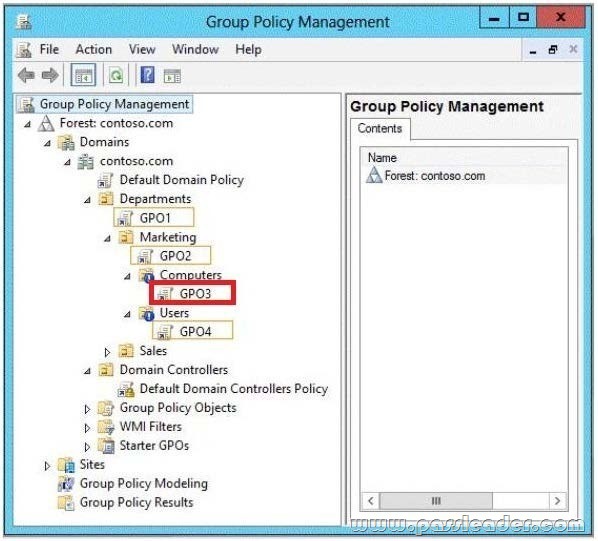
Explanation:
http://technet.microsoft.com/en-us/library/ee449496%28v=ws.10%29.aspx
QUESTION 225
Your network contains an Active Directory domain named contoso.com. The domain contains a server named Server 1. Server1 runs Windows Server 2012 R2. You need to create 3-TB virtual hard disk (VHD) on Server1. Which tool should you use?
A. New-StorageSubsytemVirtualDisk
B. Share and Storage Management
C. Computer Management
D. File Server Resource Manager (FSRM)
Answer: C
Explanation:
For other questions to create a VHD (file) you can use computer management.
– Share and storage management (2008 only)
– New-storagesubsystemVirtualDisk (this is a virtual disk, NOT a virtual hard disk)
– Server Manager (you would use this to create virtual disks, not virtual hard disks)
QUESTION 226
Your network contains an Active Directory domain named contoso.com. All servers run Windows Server 2012 R2. When a domain user named User3 attempts to log on to a client computer named Client10, User3 receives the message shown in the following exhibit. (Click the Exhibit button.)

You need to ensure that User3 can log on to Client10. What should you do?
A. From Active Directory Users and Computers, configure the Logon Workstations setting of User3.
B. On Client10, modify the Allow log on locally User Rights Assignment.
C. From Active Directory Users and Computers, configure the Personal Virtual Desktop property of User3.
D. On Client10, modify the Deny log on locally User Rights Assignment.
Answer: A
QUESTION 227
Your network contains an Active Directory domain named contoso.com. The domain contains a member server named Server1 and a domain controller named DC2. All servers run Windows Server 2012 R2. All domain controllers are configured as DNS servers. On Server1, you open Server Manager and you add DC2 as another server to manage. From Server Manager on Server2, you right-click DC2. You need to ensure that when you right-click DC2, you see the option to run DNS Manager. What should you do?

A. In the domain, add Server1 to the DNS Admins group.
B. On DC2 and Server1, run winrmquickconfig.
C. On DC2, install the Feature Administration Tools.
D. On Server1, install the Role Administration Tools.
Answer: D
Explanation:
If you have installed Windows Server 2012 R2 Roles and Features using PowerShell or remote server admin tools or new multi server manager console, you will see that the management tools are missing from the server on which you just have enabled the role or feature. This is because Microsoft has provided more granular control on what is installed on the Windows Server 2012 R2. As an administrator we have choice to include or not to include management tools while installing the Roles and Features we choose. The goal for Windows Server 2012 administration is to manage remotely from Windows Server 2012 box that will act as the management host for all servers and will be accessed by all the IT administrators. Typically, when a role is installed, the associated administration tools are also installed. However, sometimes you simply need to add additional administrative tools.
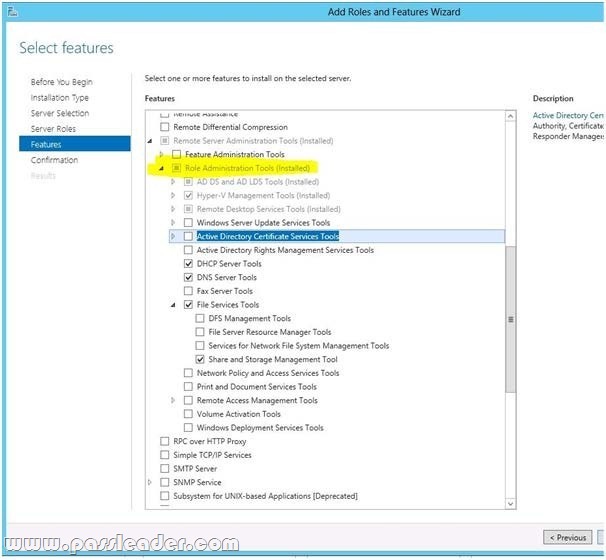
http://technet.microsoft.com/en-us//library/cc731420%28v=ws.10%29.aspx
http://windowsitpro.com/windows-server-2012/q-im-missing-some-windows-server-2012administration-toolshow-do-i-add-them
QUESTION 228
You have a server named Server1 that runs Windows Server 2012 R2. A network technician installs a new disk on Server1 and creates a new volume. The properties of the new volume. You need to ensure that you can restore files on volume D by using the Previous Versions tab. What should you do first?

A. Convert the disk to a dynamic disk.
B. Format volume D.
C. Install the File Server Resource Manager role service.
D. Run the convert.exe command.
Answer: B
Explanation:
Shadow Copies for Shared Folders is activated at the volume level. The volume to be enabled for shadow copies must use NTFS and can be saved either on a basic disk or a dynamic disk. Assigning a drive letter to the volume is optional; an NTFS volume with shadow copy enabled can be mounted as a folder on another NTFS volume. You can only enable Shadow Copies of Shared Folders on a per-volume basis; that is, you cannot select specific shared folders and files on a volume to be copied or not copied. By default, the shadow copies will be stored on the volume that is being copied (the source volume). If you have more than one drive available on your server, you should use a separate volume on another disk to store the shadow copies. This eliminates the possibility that high input/output (I/O) load will cause shadow copies to be deleted. This is the recommended configuration for heavily used file servers.


http://technet.microsoft.com/pt-pt/magazine/2006.01.rapidrecovery%28en-us%29.aspx
http://technet.microsoft.com/en-us/library/cc875808.aspx
QUESTION 229
Your network contains an Active Directory domain named contoso.com. The domain contains a server named Server1. Server1 runs Windows Server 2012 R2 and has the Hyper-V server role installed. On Server1, you create and start a virtual machine named VM1.
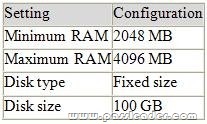
VM1 is configured as shown in the following table. You plan to create a snapshot of VM1. You need to recommend a solution to minimize the amount of disk space used for the snapshot of VM1. What should you do before you create the snapshot?
A. Shut down VM1.
B. Decrease the Minimum RAM.
C. Decrease the Maximum RAM.
D. Configure VM1 to have a smaller virtual disk.
E. Convert disk1.vhd to a dynamically expanding disk.
F. Run the Stop-VM cmdlet.
G. Run the Resize-VHD cmdlet.
H. Run the Convert-VHD cmdlet.
Answer: AF
Explanation:
Virtual machine snapshots are file-based snapshots of the state, disk data, and configuration of a virtual machine at a specific point in time. You can take multiple snapshots of a virtual machine, even while it is running. You can then revert the virtual machine to any of the previous states by Applying a snapshot to the virtual machine. Taking a snapshot of a VM is to in essence freeze the current state and make it a parent disk based on current state, and at the same time create a child disk to capture all subsequent changes.(See more at: Snapshots require adequate storage space.) Snapshots are stored as .avhd files in the same location at the virtual hard disk. Taking multiple snapshots can quickly consume a large amount of storage space. When you use Hyper-V Manager to delete a snapshot, the snapshot is removed from the snapshot tree but the .avhd file is not deleted until you turn off the virtual machine. Each snapshot introduces a parent-child dependency of the runtime environment when the snapshot wastaken, and over time a series of backups will results in a multi-level hierarchy of snapshots with nested parent child dependencies. When you have systems that are required to be up and running 24/7 it basically throws away any use that snapshots have. It seems somewhat ridiculous that you have to bring a system down to delete the snapshot when one of the reasons you created the snapshot was to help reduce downtime in case something goes wrong. It is even more ridiculous that if you don’t power down your system and wait for the vhd to merge, the snapshot will continue to grow until the system comes crashing down due to a lack of disk space! (Microsoft does not recommend snapshots for production environments)
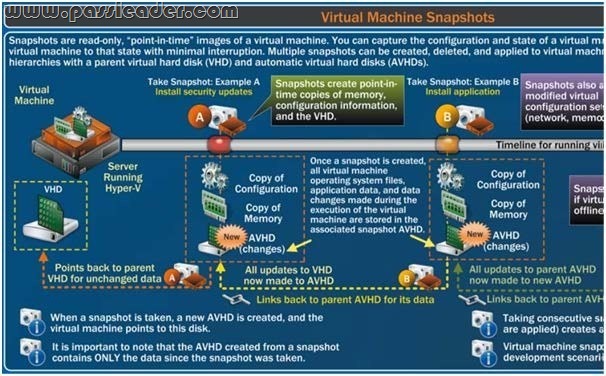
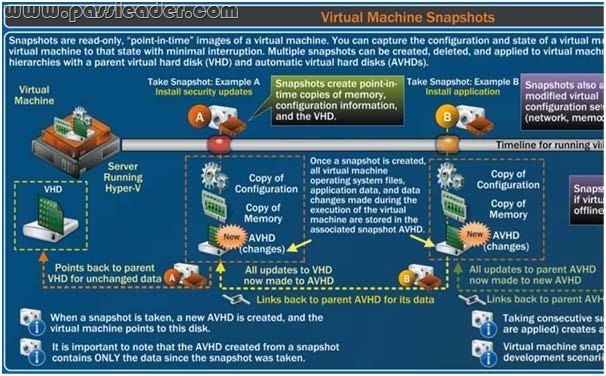
http://www.laneolson.ca/2009/10/09/hyper-v-snapshots-and-disk-space/
http://blogs.technet.com/b/yungchou/archive/2013/01/23/hyper-v-virtual-hard-disk-vhdoperations-explained.aspx
http://zoom.it/12u8
http://www.server-talk.eu/wp-content/uploads/article_2010-05-28_02.png
http://blogs.msdn.com/b/virtual_pc_guy/archive/2009/04/15/what-happens-when-i-delete-asnapshot-hyper-v.aspx
QUESTION 230
Your network contains an Active Directory domain named contoso.com. The domain contains a server named Server1. Server1 runs Windows Server 2012 R2. You need to create 3-TB virtual hard disk (VHD) on Server1. Which tool should you use?
A. Diskpart
B. Server Manager
C. Computer Management
D. New-VirtualDisk
E. Share and Storage Management
F. File Server Resource Manager (FSRM)
G. New-StorageSubsytemVirtualDisk
H. New-StoragePool
Answer: AC
Explanation:
The New-VirtualDisk command creates a new virtual disk in the specified storage pool. New-VirtualDisk – Creates a new virtual disk in the specified storage pool. Although the new Server Manager UI in Windows Server 2012 R2 provides a very convenient and intuitiveworkflow to provision and manage Storage, interaction with PowerShell is required to access many of theadvanced features. If I then create a simple 200GB Virtual Disk via the UI named VDiskSimpleUI, the resulting Virtual Diskleverages 8 columns and maintains 1 copy of the data. But when creating the Virtual Disk via PowerShell, Ican force the tripping across all nine of the disks and optimize performance.
http://blogs.technet.com/b/wincat/archive/2012/05/21/optimizing-windows-server-2012storage-managementvia-powershell-for-both-performance-and-resiliency.aspx http://technet.microsoft.com/en-us/library/hh848643%28v=wps.620%29.aspx
QUESTION 231
Your network contains an Active Directory domain named contoso.com. The domain contains two servers named Server1 and Server2. Server1 runs Windows Server 2012 R2. Server2 runs Windows Server 2008 R2 Service Pack 1 (SP1) and has the DHCP Server server role installed. You need to manage DHCP on Server2 by using the DHCP console on Server1. What should you do first?
A. From Server Manager on Server2, enable Windows Remote Management.
B. From a command prompt on Server2, run winrm.exe.
C. From Server Manager on Server1, install a feature.
D. From the Microsoft Management Console on Server1, add a snap-in.
Answer: C
Explanation:
When the DHCP role is installed, it appears that the firewall rules are automatically added. This means you only need to add the DHCP Manager MMC snap-in which is a Role Administration Tool feature.
QUESTION 232
Your network contains a production Active Directory forest named contoso.com and a test Active Directory forest named contoso.test. A trust relationship does not exist between the forests. In the contoso.test domain, you create a backup of a Group Policy Object (GPO) named GPO1. You transfer the backup of GPO1 to a domain controller in the contoso.com domain. You need to create a GPO in contoso.com based on the settings of GPO1. You must achieve this goal by using the minimum amount of administrative effort. What should you do?
A. From Group Policy Management, right-click the Group Policy Objects container, and then click Manage Backups.
B. From Group Policy Management, right-click the Starter GPOscontainer, and then click Manage Backups.
C. From Group Policy Management, create a new starter GPO.
Right-click the new starter GPO, and then click Restore from Backup.
D. From Group Policy Management, create a new GPO.
Right-click the new GPO, and then click Import Settings.
E. From Windows PowerShell, run the Copy-GPOcmdlet and the Restore-GPO cmdlet.
F. From Windows PowerShell, run the New-GPOcmdlet and the Import-GPO cmdlet.
G. From Windows PowerShell, run the New-GPOcmdlet and the Restore-GPO cmdlet.
H. From Windows PowerShell, run the Get-GPOcmdlet and the Copy-GPO cmdlet.
Answer: DF
Explanation:
The New-GPO cmdlet creates a new GPO with a specified name. By default, the newly created GPO is not linked to a site, domain, or organizational unit (OU). The Import-GPO cmdlet imports the settings from a GPO backup into a specified target GPO. The target GPO can be in a different domain or forest than that from which the backup was made and it does not have to exist prior to the operation. The Restore-GPO cmdlet restores a GPO backup to the original domain from which it was saved. If the original domain is not available, or if the GPO no longer exists in the domain, the cmdlet fails.
http://technet.microsoft.com/en-us/library/cc781458(v=WS.10).aspx
http://technet.microsoft.com/en-us/library/hh967461.aspx
http://technet.microsoft.com/en-us/library/ee461050.aspx
http://technet.microsoft.com/en-us/library/ee461044.aspx
http://blogs.technet.com/b/askpfeplat/archive/2012/11/04/windows-server-2012-the-newand-improved-grouppolicy-management-console.aspx
QUESTION 233
You work as an administrator at contoso.com. The contoso.com network consists of a single domain named contoso.com. All servers on the contoso.com network have Windows Server 2012 R2 installed. You have received instructions to convert a basic disk to a GPT disk. Which of the following is TRUE with regards to GPT disks? (Choose all that apply.)
A. To convert a basic disk to a GPT disk, the disk must not contain any partitions or volumes.
B. You can convert a basic disk to a GPT disk, regardless of partitions or volumes.
C. GPT is required for disks larger than 2TB.
D. GPT is required for disks smaller than 2TB.
E. The GPT partition style can be used on removable media.
F. GPT disks make use of the standard BIOS partition table.
Answer: AC
Explanation:
A. For a drive to be eligible for conversion to dynamic, all basic data partitions on the drive must be contiguous.
C. GPT allows a much larger partition size greater than 2 terabytes (TB).
D. 2 terabytes is the limit for MBR disks.
E. Dynamic disks are not supported on portable computers, removable disks, detachable disks that use USB or IEEE 1394 interfaces.
F. Windows only supports booting from a GPT disk on systems that contain Unified Extensible Firmware Interface (UEFI) boot firmware.
Master boot record (MBR) disks use the standard BIOS partition table. GUID partition table (GPT) disks use unified extensible firmware interface (UEFI). One advantage of GPT disks is that you can have more than four partitions on each disk. GPT is also required for disks larger than 2 terabytes. Portable computers and removable media. Dynamic disks are not supported on portable computers, removable disks, detachable disks that use Universal Serial Bus (USB) or IEEE 1394 (also called FireWire) interfaces, or on disks connected to shared SCSI buses. If you are using a portable computer and right-click a disk in the graphical or list view in Disk Management, you will not see the option to convert the disk to dynamic. Dynamic disks are a separate form of volume management that allows volumes to have noncontiguous extents on one or more physical disks. Dynamic disks and volumes rely on the Logical Disk Manager (LDM) and Virtual Disk Service (VDS) and their associated features. These features enable you to perform tasks such as converting basic disks into dynamic disks, and creating fault-tolerant volumes. To encourage the use of dynamic disks, multi-partition volume support was removed from basic disks, and is now exclusively supported on dynamic disks. GPT disks can be converted to MBR disks only if all existing partitioning is first deleted, with associated loss of data.
What happens when a basic disk is converted to dynamic?
For a drive to be eligible for conversion to dynamic, all basic data partitions on the drive must be contiguous. If other unrecognized partitions separate basic data partitions, the disk cannot be converted. This is one of the reasons that the MSR must be created before any basic data partitions. The first step in conversion is to separate a portion of the MSR to create the configuration database partition. All non-bootable basic partitions are then combined into a single data container partition. Boot partitions are retained as separate data container partitions. This is analogous to conversion of primary partitions. Windows XP and later versions of the Windows operating system differs from Windows 2000 in that basic and extended partitions are preferentially converted to a single 0x42 partition, rather than being retained as multiple distinct 0x42 partitions as on Windows 2000.
http://technet.microsoft.com/en-us/library/cc725671.aspx
http://msdn.microsoft.com/en-us/library/windows/desktop/aa363785%28v=vs.85%29.aspx
http://msdn.microsoft.com/en-us/library/windows/hardware/gg463525.aspx
http://technet.microsoft.com/en-us/library/cc757696.aspx
http://technet.microsoft.com/en-us/library/cc776315.aspx
QUESTION 234
Server1 runs Windows Server 2012 R2 and is installed as an FTP server. Client use App1 to connect to Server1 for FTP. App1 use TCP port 21 for control and a dynamic port for data. You have allowed port 21 in firewall. What youshould next do to allow clients to use App1 to connect to server1 using ftp.
A. At Server1 allow firewall rule of outbound
B. At Server1 allow firewall rule of inbound
C. Netsh advfirewalldomainprofile state off
D. Netsh advfirewall set global StatefulFtp enable
Answer: D
Explanation:
Set global statefulftp. Configures how Windows Firewall with Advanced Security handles FTP traffic that uses an initial connection onone port to request a data connection on a different port. This affects both active and passive FTP.

http://technet.microsoft.com/en-us/library/cc771920%28v=ws.10%29.aspx
http://support.microsoft.com/kb/832017/en-us#method20
QUESTION 235
You have a server named Server1 that runs Windows Server 2012 R2. You plan to enable Hyper-V Network Visualization on Server1. You need to install the Windows Network Virtualization Filter Driver on Server1. Which Windows PowerShell cmdlet should you run?
A. Set-NetVirtualizationGlobal
B. Set-NetAdapterVmq
C. Add-WindowsFeature
D. Enable-NetAdapterBinding
Answer: D
Explanation:
Hyper-V Network Virtrtualization runs multiple virtual networks on a physical network. And each virtual network operates as if it is running as a physical network. The The Set-NetAdapter cmdlet sets the basic properties of a network adapter such as virtual LAN (VLAN) identifier (ID) and MAC address. Thus if you add the binding parameter to the command then you will be able to install the Windows Network Virtualization Filter Driver. Step one:Enable Windows Network Virtualization (WNV). This is a binding that is applied to the NIC that you External Virtual Switch is bound to. This can be a physical NIC, it can be an LBFO NIC team. Either way, it is the network adapter that your External Virtual Switch uses to exit the server.This also means that if you have multiple virtual networks or multiple interfaces that you can pick and choose and it is not some global setting.
QUESTION 236
A company has a forest with 4 sites. Subnets are as follows:
– MainOffice 172.16.1.0 Subnet: 255.255.255.0 Gateway 172.16.1.254
– Site1 192.168.12.0 Subnet: 255.255.255.0
– Site 2 192.168.13.0 Subnet: 255.255.255.0
– Site 3 192.168.14.0 Subnet: 255.255.255.0
– Site 4 192.168.15.0 Subnet: 255.255.255.0
You add a new server to the MainOffice and it needs to be able to communicate to all sites. Which route command would you run?
A. route add -p 192.168.8.0 netmask 255.255.252.0 172.16.1.254
B. route add -p 192.168.0.0 netmask 255.255.248.0 172.16.1.254
C. route add -p 192.168.12.0 netmask 255.255.252.0 172.16.1.254
D. route add -p 192.168.12.0 netmask 255.255.240.0 172.16.1.254
Answer: C
QUESTION 237
Server 1 and Server2 host a load-balanced Application pool named AppPool1. You need to ensure that AppPool1 uses a group Managed Service Account as its identity. Which 3 actions should you perform?
A. Install a domain controller that runs Windows Server 2012 R2, Run the New- ADServiceAccount cmdlet, Modify the settings of AppPool1.
B. Configure the Security settings of the contoso.com zone.
C. Add a second legacy network adapter, and then run the Set-VMNetworkAdopter cmdlet.
D. From Windows Powershell, run Get-DNSServerDiagnostics.
Answer: A
Explanation:
For the application pool to use a group Managed Service account as its identity you will have to make sure that there is a domain controller where you can add the account and then modify the application pool accordingly. Thus you should use the New-ADServiceAccount on the domain controller that will create a new Active Directory service account.
QUESTION 238
Hotspot Question
You run a Windows Server 2012 R2and implementing 3 new printers in a warehouse. You need to makean exclusion forthese IP addresses within DHCP server. Select the location where would configure at the DHCP console?
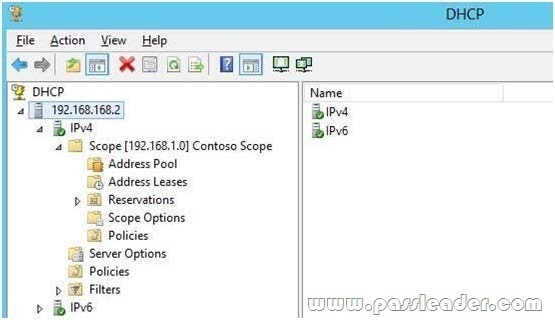
Answer:

Explanation:
http://technet.microsoft.com/en-us/library/cc737978%28v=ws.10%29.aspx
QUESTION 239
Hotspot Question
You have a Server Core 2012 installation and all roles and features removed. The server does not haveaccess to Windows Update. You mount the network volume containing the installation files for Server 2012. You need to install DNS and DHCP server role. Which directory do you reference for installing?

Answer:

Explanation:
http://blogs.technet.com/b/askpfeplat/archive/2013/02/24/how-to-reduce-the-size-of-the-winsxs-directory-and-free-up-disk-space-on-windows-server-2012-using-features-on-demand.aspx
QUESTION 240
Server1 runs Windows Server 2012 R2 and is installed as an FTP server. Client use App1 to connect to Server1 for FTP. App1 use TCP port 21 for control and a dynamic port for data. You have allowed port 21 in firewall. What youshould next do to allow clients to use App1 to connect to server1 using ftp.
A. At Server1 allow firewall rule of outbound
B. At Server1 allow firewall rule of inbound
C. netshadvfirewalldomainprofile state off
D. netshadvfirewall set global StatefulFtp enable
Answer: D
Explanation:
Set global statefulftp. Configures how Windows Firewall with Advanced Security handles FTP traffic that uses an initial connection onone port to request a data connection on a different port. This affects both active and passive FTP.

http://technet.microsoft.com/en-us/library/cc771920%28v=ws.10%29.aspx
http://support.microsoft.com/kb/832017/en-us#method20
Get the newest PassLeader 70-410 VCE dumps here: http://www.passleader.com/70-410.html (512 Q&As Dumps –> 528 Q&As Dumps)
And, DOWNLOAD the newest PassLeader 70-410 PDF dumps from Cloud Storage for free: https://drive.google.com/open?id=0B-ob6L_QjGLpfnJzOE1fWnlJOWVtaE93SnJNT3gtaTNYYnVpZkw5THBSMWRKbFlfaXh1azg


